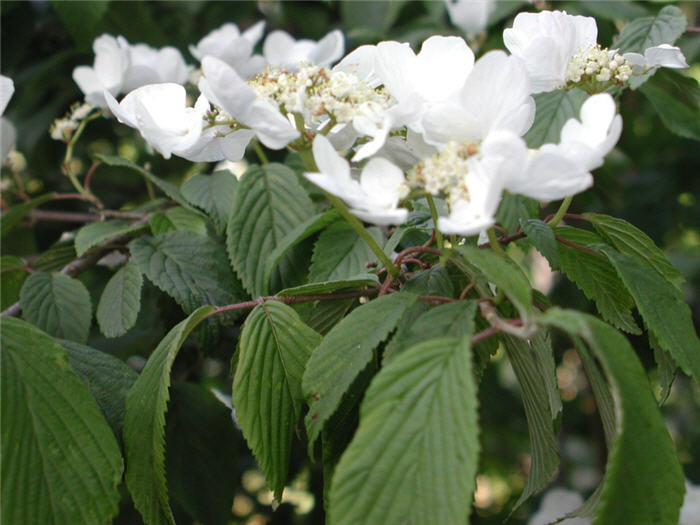| Botanical Name: Viburnum plicatum var. tomentosum | |
| Common Name: Doublefile Viburnum |

-
Anatomy
-
Culture
-
Design
Plant Type
Shrub
Height Range
6-12'
Flower Color
White
Flower Season
Spring
Leaf Color
Green
Bark Color
Brown, Grey
Fruit Color
Black, Red
Fruit Season
Summer, Fall
Sun
Full, Half
Water
Medium, Extra in Summer
Growth Rate
Moderate
Soil Type
Clay, Loam
Soil Condition
Average, Rich, Poor, Well-drained
Soil pH
Neutral
Adverse Factors
n/a
Design Styles
English Cottage, Formal, Japanese, Woodland
Accenting Features
Fall Color, Showy Flowers, Silhouette
Seasonal Interest
Spring, Summer, Fall
Location Uses
Background, Shrub Border, Foundation, Patio, Walls / Fences
Special Uses
Cut Flowers, Hedge, Screen, Mass Planting
Attracts Wildlife
Birds
Information by: Stephanie Duer
Photographer: Steve Mullany
Photographer: Steve Mullany
-
Description
-
Notes
Doublefile are generally large, deciduous viburnum with a broadly rounded form, horizontal branching, multi-stemmed habit growing 8 to 10 feet tall and generally wider than tall. Leaves are early to emerge, are roughly oval with pointed tip and base, serrated margins, of dark green color, and with slightly hairy undersides. Fall color is purplish red. Flowers are white, in flat-topped clusters, and appear in May; followed by fruits which ripen to red and then black in August and is much enjoyed by birds. Use in shrub and foundation borders, as a screen or hedge, or mass planting. A number of cultivars are available.
Grow in well drained, loamy soils in full sun to partial shade. Though adaptive to soil types, prefers those that are loamy. Avoid shearing as it ruins the lovely horizontal branching pattern; if pruning is required to control size, do so infrequently and selectively (see guides). V. plicatum is a very similar cultivar, and it seems sometimes as if the two are used interchangeably. The only important difference between the two are that V.p. var. tomentosum blooms a couple weeks later, with the flowers tending to more of a "lacecap" appearance. Otherwise, nearly identical.